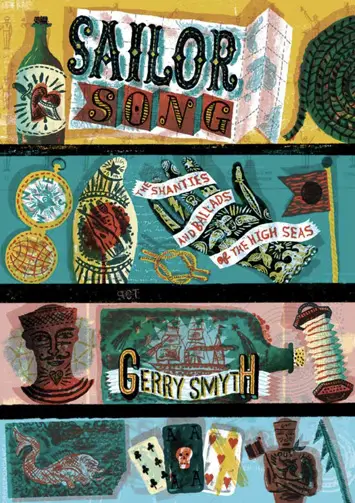Sailor Song: The Shanties and Ballads of the High Seas by Gerry Smyth – Review

With a trend for sea shanties currently sweeping certain social media platforms it seemed a timely opportunity to delve more deeply into this historical art form through the very beautiful book, Sailor Song, recently published by the British Library.
Author Gerry Smyth is an academic, musician, actor and playwright, and also leader of ‘The Full Shanty’, Liverpool John Moore University’s shanty choir. This rather unique combination of skills and interests combines to produce an extremely well-researched but also very accessible book that is full of privileged insights into not only the songs as compositions and historical records but also into the experience of actually singing them.
Coupled with the rich text are gorgeous illustrations by John Hannah that take the publication from being a fascinating read into the realms of a treasure.
The book begins with an introduction to how and why sea shanties came about and how this was symbiotically linked with the establishment of regular shipping runs between (initially) New York and Liverpool.
 The development of different styles of song according to the work required is also explored, so one type, the ‘capstan’, was chiefly sung to accompany tasks of pushing or heaving, whilst the ‘halyard’ would be for pulling or hauling, for example. The role of the ‘shantyman’ is introduced – the soloist who chooses the appropriate song for the task in hand and leads the singing – and the general significance of singing onboard ship is discussed.
The development of different styles of song according to the work required is also explored, so one type, the ‘capstan’, was chiefly sung to accompany tasks of pushing or heaving, whilst the ‘halyard’ would be for pulling or hauling, for example. The role of the ‘shantyman’ is introduced – the soloist who chooses the appropriate song for the task in hand and leads the singing – and the general significance of singing onboard ship is discussed.
“Hooked”
The main body of the book contains the sea shanties and ballads of the high seas themselves. Each of the fifty songs are set out with both the melody and lyrics, as well as a page of richly detailed information about each, explaining references, the type of labour that it would have accompanied, notes about performance, what the song reveals about life at that time and so on.
As one might expect various themes recur throughout the songs: love and loss, saying goodbye to sweethearts, ports of the world, alcohol, and a great many entertaining tales about individuals and their lives (such as the unfortunate Reuben Ranzo: ‘Ranzo was no beauty, So he could not do his duty’!).
Interspersed throughout the book are short chapters covering a range of shanty-related topics, such as people, folk music and the life of the sailors who sang the songs. For readers who want to explore further, Smyth provides both a very useful glossary and suggestions for further reading and listening.
Finally (and topically, given the recent TikTok shanty phenomenon), there is a chapter about sea shanties in the modern day. This has been thoughtfully put at the end, possibly to enable a smooth transition back to the present day having been taken on such maritime adventures by what is a truly brilliant book.
As someone unaware of having had any particular interest in songs of the sea, I can honestly say I am now hooked and thanks to Smyth’s full referencing, I can explore more. I doubt, however, that there will be any book about sea shanties better than this!
‘Sailor Song: The Shanties and Ballads of the High Seas’ by Gerry Smyth is published by the British Library, £14.99 hardback









